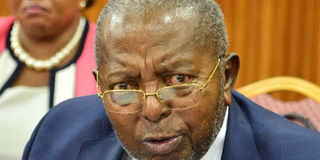BoU fixes lowest CBR at 7% as economy declines

Bank of Uganda Governor Emmanuel Tumusiime- Mutebile. PHOTO/ALEX ESAGALA
What you need to know:
- While there are no demand side pressures evident, cost push pressures emanating from higher taxes on imported consumer and intermediate products and social distancing measures could cause inflation to edge up further in coming months.
The weak economic growth being projected during the Financial Year (FY) 2020/2021 has forced Bank of Uganda (BoU) to maintain Central Bank Rate (CBR) at 7 per cent, its lowest level, to support economic activities.
The Monetary Policy Committee (MPC) of the central bank yesterday said the high frequency indicators for economic activity in the quarter to September, point to a mild recovery of economic activity with estimated growth of 2 per cent from a sharp contraction of 6 per cent in the quarter to June.
In a public statement issued following the MPC meeting, the governor BoU, Mr Emmanuel Tumusiime Mutebile, said the simultaneous fiscal, monetary, and financial stimuli have been effective in avoiding the most negative economic consequences of the Covid-19 shock.
“The easing of the lockdown, the stability of the exchange rate, as well as a feeble improvement in both foreign and domestic demand are supporting economic growth recovery. However, economic growth is tepid, uneven, and still fragile and projected to contract in the range of 0.2 and 0.5 per cent in 2020,” Mr Mutebile said.
He said the GDP growth momentum in 12 to 24 months ahead is likely to be modest against the sluggish external demand, subdued consumer expenditure, the weak performance of the service sector, commercial banks’ cautious lending, and uncertain economic outlook.
“The economic outlook is extremely uncertain, largely because of the unpredictable course of the virus and the wide range of shocks hitting the economy,” he said.
Mr Mutebile said Uganda remains highly vulnerable to periodic spouts of global financial volatility, stemming from continued global economic weakness and geopolitical tensions, and increasing protectionism.
Mr Mutebile said the annual core inflation will remain above 5 per cent target in the near term but is projected to gradually converge to 5 per cent in 2022.
While there are no demand side pressures evident, cost push pressures emanating from higher taxes on imported consumer and intermediate products and social distancing measures could cause inflation to edge up further in coming months.
In addition, price pressures could increase due to the further easing of lockdown measures as households increase spending on items that they had been forced to defer, for instance expenditure on school fees. These pressures could also increase due to higher production costs from persistent supply disruptions.
The International Monetary Fund said on October 13 the global growth is projected at negative 4.4 per cent in 2020, a less severe contraction than forecast in the June 2020 World Economic Outlook (WEO) update.




